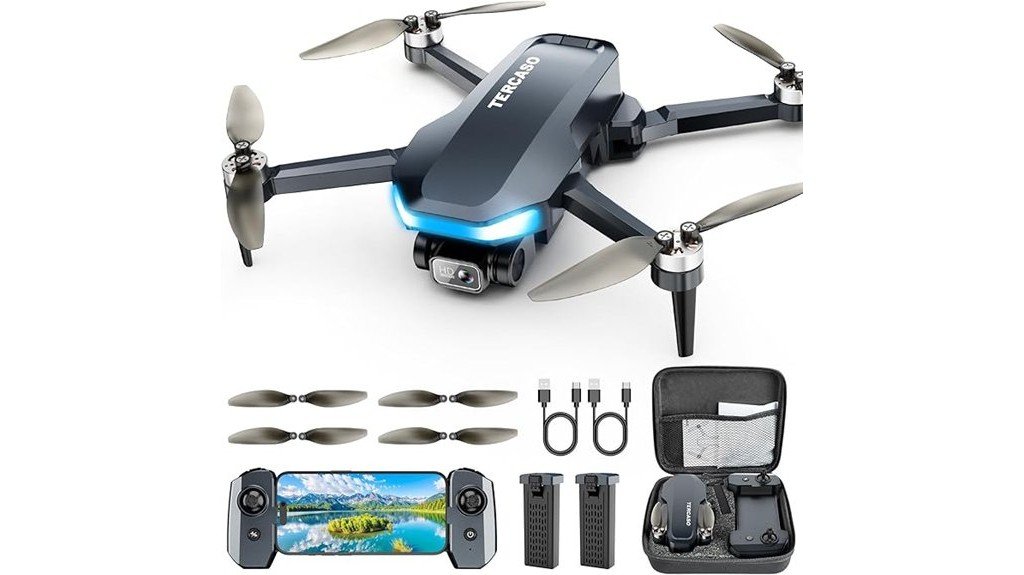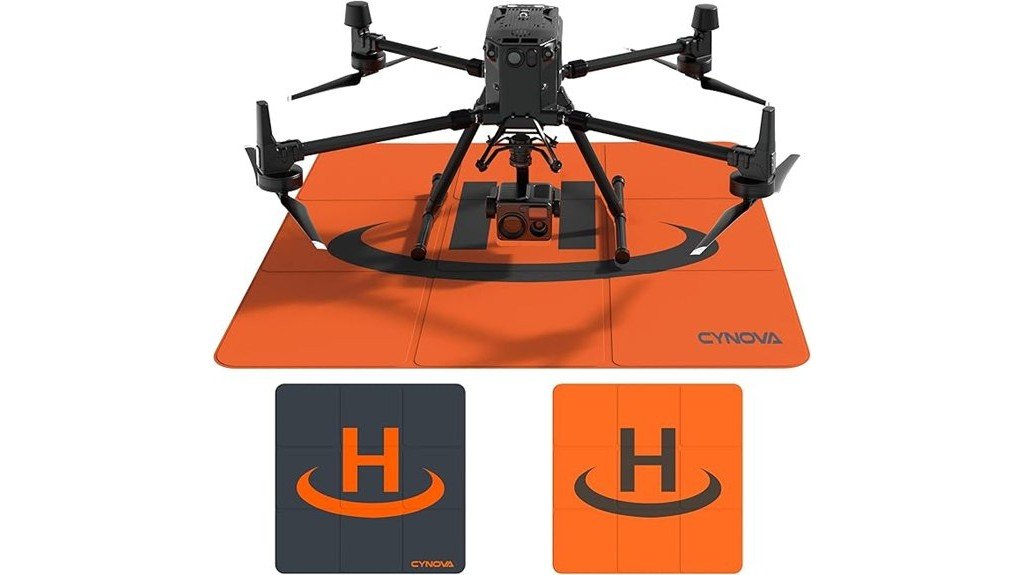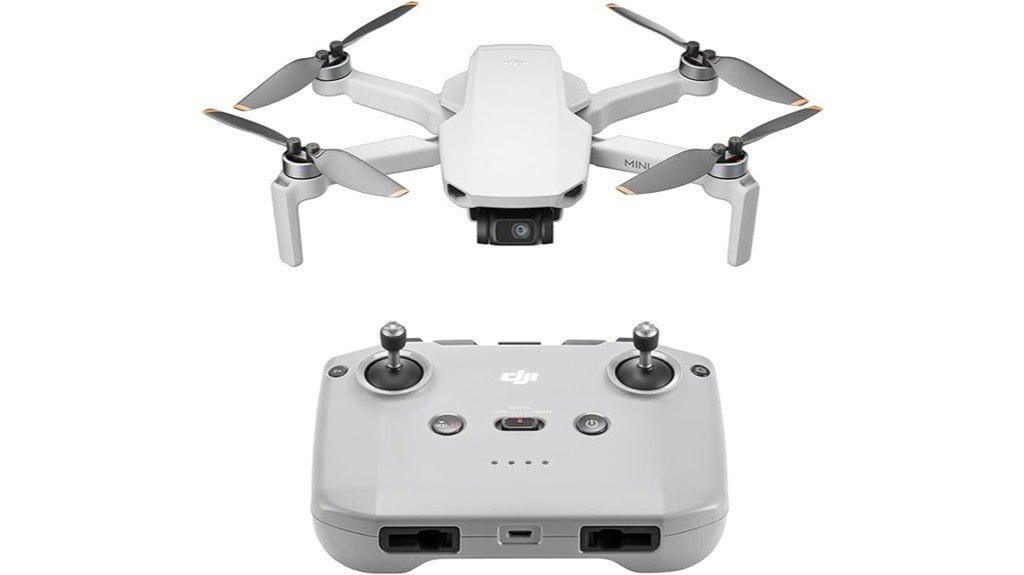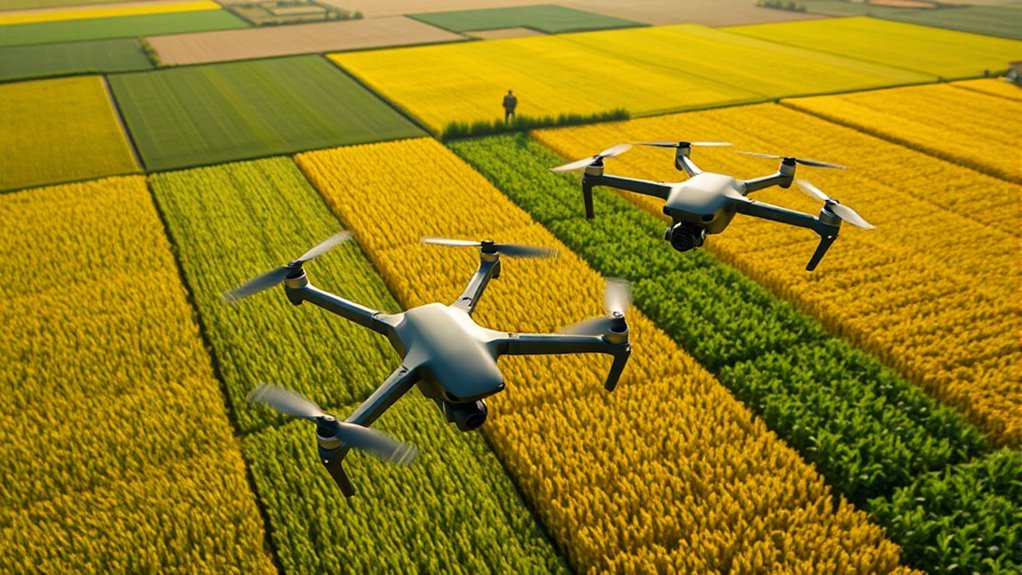In the world of agriculture, drones are like modern-day farming angels, offering a bird’s-eye view that transforms how you manage your crops. With the right drone, you can enhance your farming efficiency and precision considerably. But what features should you consider to make the right choice? Let’s explore the top options available and their unique benefits that could redefine your agricultural practices.
Drone with Camera for Adults – 2K HD Camera FPV Live Video

If you’re an adult looking to enhance your agricultural practices, the Drone with Camera for Adults featuring a 2K HD camera and FPV live video is an excellent choice. This compact, FAA-friendly drone folds easily for portability and weighs under 250g, making it perfect for on-the-go use. With its brushless motors, you’ll enjoy quieter operations and longer lifespans. The 110° wide-angle camera captures high-resolution images and videos, and the built-in shock absorption guarantees stability. Plus, the intuitive controls and safety features like auto return make it user-friendly, whether you’re a beginner or a seasoned hobbyist. Elevate your farming efficiency today!
Best For: Adults looking to enhance their agricultural practices with a user-friendly, portable drone that features advanced camera technology.
Pros:
- High-quality 2K HD camera with wide-angle view for capturing detailed images and videos.
- Portability due to its foldable design and lightweight build, making it easy to carry and transport.
- User-friendly features such as auto return, altitude hold, and intuitive controls suitable for beginners.
Cons:
- Limited flight time may require frequent battery changes or recharging during extended use.
- Camera quality may not meet professional standards for advanced aerial photography needs.
- Potential learning curve for users unfamiliar with drone operation, despite user-friendly controls.
CYNOVA 3.33 FT Waterproof Drone Landing Pad

The CYNOVA 3.33 FT Waterproof Drone Landing Pad is an ideal choice for agricultural drone enthusiasts looking to enhance their flying experience. Its durable, waterproof PU leather construction guarantees it withstands various terrains, while the weighted design keeps it stable even in windy conditions. Measuring 3.33 feet, it’s perfect for accommodating different drone sizes. The foldable design makes storage and transport a breeze, and its bright orange color offers excellent visibility. With an average rating of 4.3 stars, users appreciate its reliability during flights. However, be mindful of potential flapping in strong winds. Overall, it’s a solid addition to your drone toolkit.
Best For: The CYNOVA 3.33 FT Waterproof Drone Landing Pad is best for agricultural drone enthusiasts and hobbyists seeking a reliable and visible landing solution.
Pros:
- Durable, waterproof PU leather construction suitable for various terrains.
- Weighted design prevents movement in windy conditions.
- Foldable for easy storage and transport, with excellent visibility due to its bright orange color.
Cons:
- May experience flapping in strong winds, affecting stability.
- Lacks staking loops for additional anchoring.
- Some users report issues with LED brightness and battery life.
DJI Mini 4K Drone with UHD Camera

For farmers seeking a reliable aerial tool, the DJI Mini 4K Drone with UHD Camera stands out with its lightweight design, weighing under 249 grams, which eliminates the hassle of FAA registration. With wind resistance up to 38kph and an altitude capability of 4,000 meters, it’s perfect for various conditions. Its 4K Ultra HD camera and 3-axis gimbal guarantee cinematic-quality footage, regardless of lighting. You’ll appreciate the extended battery options, offering up to 93 minutes of flight time. User-friendly features like one-tap takeoff and intelligent flight modes make mastering aerial photography effortless, enhancing your farming efficiency considerably.
Best For: Farmers seeking a reliable and lightweight aerial tool for efficient crop monitoring and management.
Pros:
- Lightweight design under 249 grams eliminates the need for FAA registration.
- 4K Ultra HD camera with 3-axis gimbal ensures high-quality aerial footage in various lighting conditions.
- User-friendly features, including one-tap takeoff and intelligent flight modes, make it easy for beginners.
Cons:
- Limited to a maximum altitude of 4,000 meters, which may not be sufficient for some applications.
- Battery life, while extended with multiple options, may still limit prolonged use in larger areas.
- Some advanced features may require additional learning or experience to fully utilize.
Factors to Consider When Choosing a Drone for Agriculture
When choosing a drone for agriculture, you need to think about several key factors. Consider the drone’s weight, camera quality, and flight time, as these directly impact its performance in the field. Additionally, look for features that enhance adaptability to different terrains and guarantee user-friendly controls for ease of operation.
Drone Weight Considerations
Weight plays a pivotal role in selecting the right drone for agricultural tasks. Lighter drones, typically under 250g, are more portable and easier to maneuver, especially when you need to move frequently across fields. However, heavier drones offer better stability and wind resistance, which is essential for capturing accurate data in varying weather conditions. Consider that battery life can also be impacted by weight; lighter drones usually enjoy longer flight times, enabling broader land coverage. Plus, local regulations may limit the use of heavier drones, so it’s important to stay compliant. Finally, the payload capacity, influenced by the drone’s weight, directly affects its ability to carry essential sensors and equipment for tasks like crop monitoring and pesticide application.
Camera Quality Importance
Selecting a drone with high-quality camera capabilities is essential for effective agricultural management, as detailed imagery can greatly impact your ability to monitor crop health and identify issues like pest infestations. Opt for drones featuring 2K or 4K resolution cameras that provide sharp, clear images. A wide-angle lens, around 110°, offers broader field coverage, allowing you to capture critical data in fewer flights. Look for stability features, like gimbals, to guarantee steady images even in windy conditions. Real-time image transmission via FPV lets you make immediate decisions, enhancing your efficiency. Additionally, advanced functions such as adjustable angles and high-resolution storage enable thorough analysis and documentation of your agricultural practices over time, ensuring you’re always one step ahead.
Flight Time Efficiency
To maximize efficiency in agricultural tasks, flight time efficiency is a critical factor when choosing a drone. Longer battery life means you can cover more fields without needing to recharge frequently. Opt for lighter models, as they typically have longer flight times, making them ideal for tasks like crop monitoring. Consider drones with multiple battery options, allowing you to customize configurations based on your operational needs. Intelligent flight modes can further optimize your flight paths, cutting down unnecessary flight time and enhancing productivity. Finally, don’t overlook regular maintenance of components like batteries and motors; keeping them in top shape guarantees your drone performs at its best during those time-sensitive agricultural operations.
Terrain Adaptability Features
When considering terrain adaptability features for agricultural drones, it’s vital to guarantee they can operate effectively across various surfaces, from grass to sand. Look for models that include a landing pad, which offers a stable surface for takeoff and landing, especially on uneven or soft ground. Additionally, wind resistance capabilities are essential to make sure your drone can handle aerial operations in varying weather conditions without being swayed by gusts. The weight of the drone matters too; lighter models generally perform better on softer terrains. Some drones even feature adjustable landing gear or foldable designs, making them easier to transport and adaptable to diverse agricultural environments. These features can notably enhance your farming efficiency and precision.
User-Friendly Controls
How can you guarantee that your agricultural drone is easy to operate? Look for user-friendly controls that simplify navigation and management. Many drones come with intuitive setups, allowing you to execute complex maneuvers, like automated flight paths, with just a tap. GPS technology enhances this ease, offering features like Return to Home (RTH), so your drone can safely return without you having to intervene. Additionally, drones tailored for agriculture often include multiple flight modes, catering to different skill levels, enabling a customized experience that matches your comfort. By choosing user-friendly controls, you can considerably reduce the learning curve, letting you focus on crop monitoring and data collection instead of mastering intricate flight techniques.
Safety Mechanisms Integration
Safety mechanisms are essential in agricultural drones, especially since they operate in dynamic environments where unexpected challenges can arise. Built-in overcurrent protection and emergency stop features are critical to prevent accidents during operations. Look for drones with GPS Auto Return capabilities, which can safely navigate back to a designated location if you lose signal or battery power, reducing the risk of loss. Also, consider stability features like altitude hold systems to maintain a consistent flight level while surveying fields. Wind resistance ratings guarantee stable flight in varying conditions, essential for accurate data collection and spraying. Finally, user-friendly controls help you focus on your task without getting overwhelmed by complex maneuvers, enhancing overall safety.
Battery Life Management
Battery life is a critical factor to evaluate as you choose a drone for agriculture, since extended flight times can greatly boost your productivity in the field. Look for options that offer up to 93 minutes of flight time, reducing downtime during essential tasks like crop monitoring. Efficient power management systems can further enhance operational time, so prioritize these features. Quick battery replacement and charging capabilities are also essential to minimize interruptions, especially during peak seasons. Consider the drone’s weight and design; lighter models typically consume less power, improving battery efficiency. Finally, features like GPS Return to Home (RTH) can help conserve battery life by ensuring the drone returns safely when power levels are low.
Cost-Effectiveness Analysis
When considering a drone for agriculture, it’s essential to evaluate its cost-effectiveness alongside its features. The initial investment can range from a few hundred to several thousand dollars based on capabilities. Look beyond the upfront costs; think about long-term savings from improved crop monitoring, pest detection, and resource management. Drones with high-resolution cameras and advanced features like multispectral imaging may cost more initially but can greatly enhance crop health assessment and yield predictions, leading to better returns. Don’t forget to factor in operating costs, such as maintenance and software subscriptions. Additionally, explore potential government subsidies or grants that can offset initial expenses, making drone technology a financially viable option for your farming needs.
Frequently Asked Questions
How Do Agricultural Drones Assist With Crop Monitoring?
Agricultural drones monitor crop health, assess irrigation needs, and identify pest problems. You’ll gather data quickly, analyze growth patterns efficiently, and make informed decisions effectively, all while saving time and enhancing your farming operations.
Can Drones Be Used for Livestock Management?
Yes, drones can be used for livestock management. They help you monitor herd locations, assess pasture conditions, and even check for health issues, making it easier to manage your livestock efficiently and effectively.
What Is the Typical Lifespan of an Agricultural Drone?
Most agricultural drones can last around 5 to 7 years with proper maintenance. Regular checks and software updates help extend their lifespan, ensuring you get the most out of your investment in precision farming technology.
Are Drones Suitable for Organic Farming Practices?
Yes, drones are suitable for organic farming practices. They help you monitor crop health, assess soil conditions, and manage resources efficiently, all while minimizing chemical usage and maintaining sustainable practices essential for organic farming.
How Do I Maintain My Agricultural Drone?
To maintain your agricultural drone, regularly inspect its propellers and battery, clean the sensors after flights, and update software. Picture yourself gliding through fields, ensuring your drone’s ready for the next mission, enhancing your harvest!

